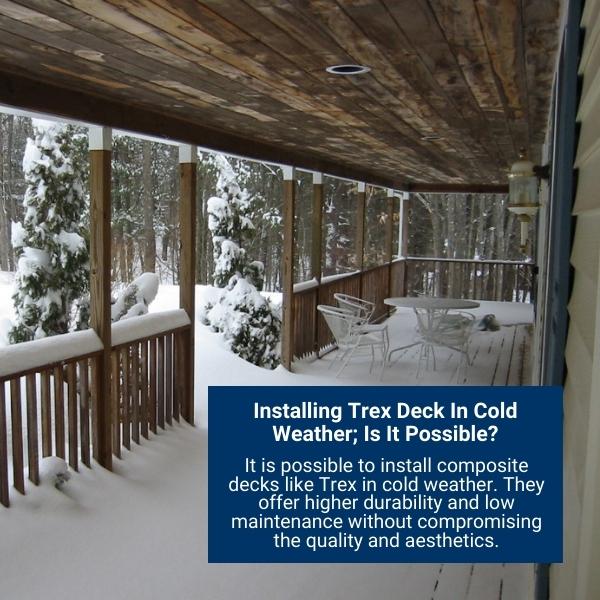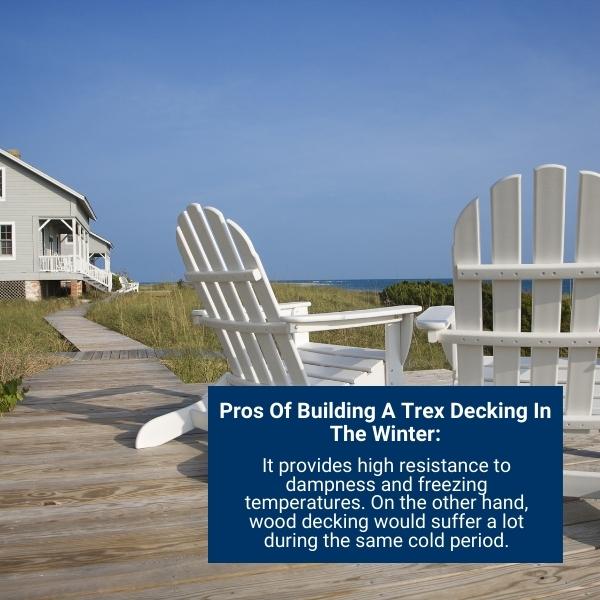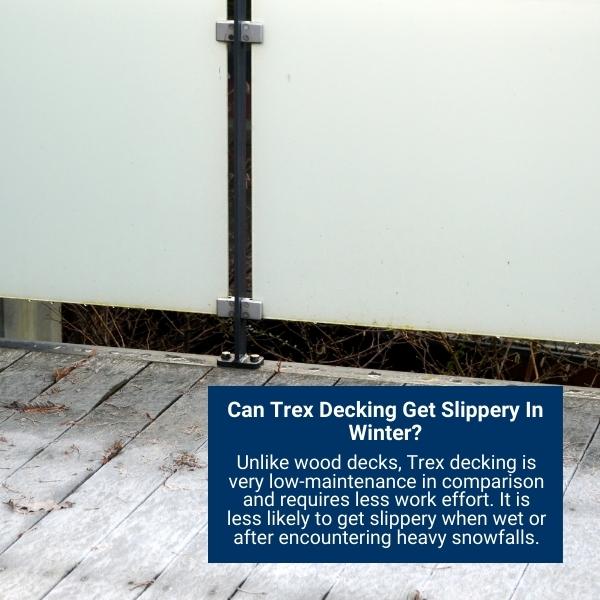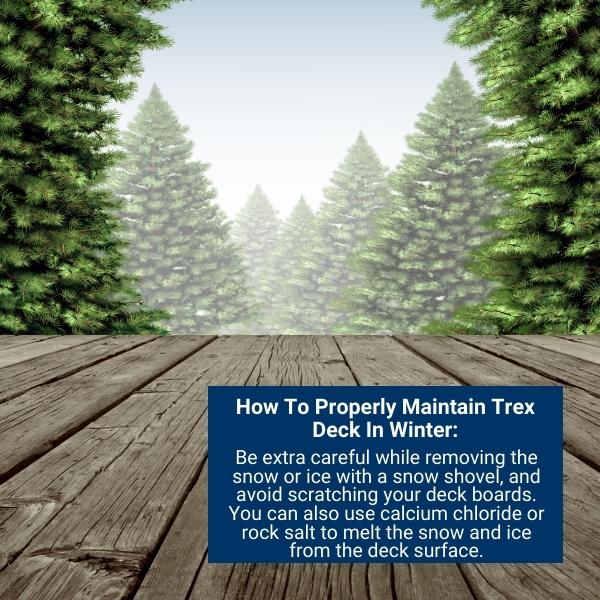Winter may not seem like the best time for many people to build a deck as the weather starts getting cooler. In reality, crisp weather is perfect for this kind of project. The deck built in winter will be ready for use when spring begins to bloom.
With the availability of so many high-quality composites, you may feel hopeful that winter will not affect your new deck too much. But, out of caution, you might be compelled to ask, can you install Trex decking in the winter?
You can install Trex composite decking in the winter, and many constructors build them in cold months. These decks are low maintenance and do not require staining or sealing. Trex decking performs better than wood in the winter plus demands minimal upkeep. They may require cleanup to avoid slipperiness.
Composite decking is designed to resist moisture, cold temperature, and sunlight exposure that comes with winter. Likewise, Trex decking tops the list of most dependable cold-weather deck materials. Let’s get to know more about them.
Installing Trex Deck In Cold Weather; Is It Possible?
Winter months can be challenging for using a deck, especially in regions where the external temperature can drop very low. Similarly, if you plan to install one, many construction companies would suggest that warm early spring or late fall is the ideal timeframe for it. The weather is usually a point of concern as many decking materials cannot withstand the extreme cold for a long time and require frequent maintenance.

However, it is possible to install composite decks like Trex in cold weather. They offer higher durability and low maintenance without compromising the quality and aesthetics. Also, unlike other decking materials, Trex does not need staining or cleaning and can remain intact throughout the winter season.
Also Read: Best Decking Material For Winter
While wood decking suffers when exposed to harsh weather, Trex composite decking performs well even when covered with ice and snow and does not undergo rotting or warping. Thus, it is the ideal pick for colder places that witness snowfalls often.
Pros Of Building A Trex Decking In The Winter:
You can avail plenty of benefits if you consider the installation of a Trex deck in the winter season. Like other types of composite decking, it provides high resistance to dampness and freezing temperatures. On the other hand, wood decking would suffer a lot during the same cold period.

Trex composite decking requires minimal winter upkeep, and you don’t have to worry about maintaining it in a good state. They do not demand excessive preparation, coatings, and winterization. You can spend more time enjoying yourself with your family and friends rather than cleaning or staining your deck.
Moreover, high-performance materials get used in constructing Trex composite decking, allowing it to be more resilient than a limber deck. It can withstand the cold weather without losing its quality to fading, scratching, and staining. Also, the Trex composite deck does not rot or soften from exposure to moisture, snow, or ice.
You might be reluctant to use your deck during the winter months, but you will attain a great benefit by installing Trex decking in the cold season. With minimal maintenance and upkeep requirements, your deck will be ready for you to have some fun and exciting time when warmer days approach.
Also Read: Best Wood For Decking
Can Trex Decking Get Slippery In Winter?
Apart from other problems, the winter season can also cause your decks to become slippery regardless of what materials get used in their making. Unlike wood decks, Trex decking is very low-maintenance in comparison and requires less work effort. It is less likely to get slippery when wet or after encountering heavy snowfalls.

However, Trex composite decking still needs occasional checks and aftercare once in a while so to keep them in their best state. They might get a little slippery, especially older ones that experience the problem of flaking and decaying. At this point, you would have to use a slip-resistant solution as the deck might be unsafe.
Trex composite decking can also turn slippery if there is excessive accumulation of both ice and water on them. This issue is more persistent in areas prone to snowfalls. But, very few people complain about the Trex deck being too slippery. A regular cleanup and removal of snow from the decking can minimize the problem significantly, and it is easy to keep them clear of the white stuff.
Also Read: Should A Deck Be Level Or Sloped?
How To Properly Maintain Trex Deck In Winter:
The Trex deck does not need a lot of maintenance and protection effort. But, it is always a wise idea to look after it, so it remains as good as new. So, once it successfully goes through the harsh winter months, it will be ready for you to use in the spring season.

Ensure to give an occasional cleanup to your Trex deck to eliminate dirt and other unwanted buildups. When fallen leaves sit on the deck boards for too long, it gets difficult to get rid of them, so it is better to remove them timely. Similarly, snow buildup can make your composite deck slightly slippery. Thus, you need to clean it up without a prolonged delay.
Also Read: What to Put Under the Deck for Moisture? 6 Different Options
Be extra careful while removing the snow or ice with a snow shovel, and avoid scratching your deck boards. For this task, a plastic shovel is a preferable choice over a metal one, especially for an older Trex deck. You can also use calcium chloride or rock salt to melt the snow and ice from the deck surface.
Conclusion:
Many people might think installing a deck in the inter is not a good idea as many builders avoid building decks during this time. It is correct for wood material, but you can install Trex composite decking in cold weather and don’t have to worry much about damage. They are sturdy and will withstand the winter better than wood. Trex decking stays intact even in regions with a colder climate, requiring minimal upkeep, making them the best deck material for snow.

